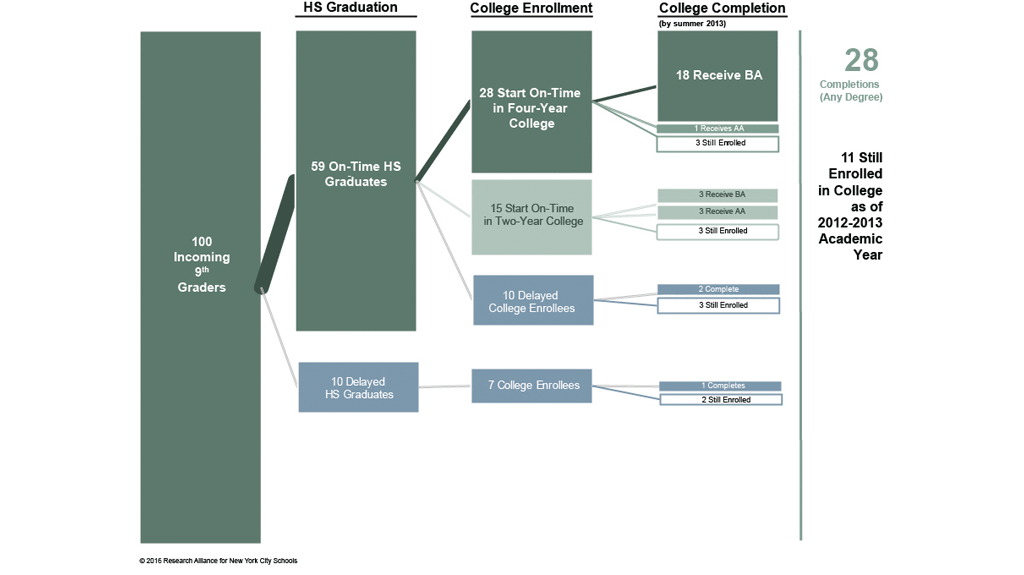In New York City and around the country, education policy is increasingly focused not only on boosting college enrollment but also on raising the number of students who successfully complete college. This stems from a growing awareness of the pitfalls that many students face on their way to a college degree, including a range of academic, social and financial barriers.[1] One way that systems can begin to address these barriers is to look at key milestones on the path into and through college—where are students successfully managing transitions, and where are they falling off track?
The following figure presents the educational trajectories of students who entered 9th grade in a NYC public school in 2003. The data allow us to follow these students for a full 10 years after their entry into high school.[2] (For an updated and more in-depth discussion of this analysis, please see our New York City Goes to College: New Findings and Framework for Examining College Access and Success report.)
The Path to a College Degree: Incoming 9th Graders, Fall 2003

For every 100 students who started high school that year:
- 59 graduated within four years
- Another 10 graduated high school in the next two years (i.e., within six years of starting 9th grade).
- 60 students—85 percent of high school graduates—enrolled in college.
- More than 30 enrolled in a 4-year college.
- 28 earned a college degree within 10 years of entering high school.
- 22 of these earned a bachelor’s degree.
Data from a recent report from the UChicago Consortium on School Research indicates that these rates are higher than those in other large urban areas.
Looking at the different routes students took, the pathway that produced the most college diplomas, by far, was to graduate high school on time and enroll immediately in post-secondary education. Forty-three of the 100 students did this, and the majority of them entered a 4-year college:
- 25 of the 43 students who enrolled immediately (i.e., 57% of immediate enrollees) earned a college degree of some kind within six years.
- 19 of the 28 students who enrolled immediately in a four-year college (i.e., 68% of this group of enrollees) earned a degree within six years.
- 6 of the 15 students who enrolled immediately in a two-year college (i.e., 40% of this group of enrollees) earned a degree within six years.
But the picture was less promising for students who delayed graduation or college enrollment:
- Of the 10 students who graduated high school on time but delayed enrolling in college, only 2 obtained a college degree within the observed timeframe (i.e., 20% of enrollees).
- 7 of the 10 students who graduated from high school late went on to enroll in college, but only 1 obtained a college degree within the observed time frame (i.e., 14% of enrollees).[3]
Big Questions
While this analysis provides a useful picture of NYC students’ educational pathways and outcomes, it leaves many important questions unanswered about why and how students are falling off track:
- What are the characteristics, experiences, and subsequent outcomes of students who don’t complete high school?
- Why do some students graduate high school on time but delay or forgo college enrollment?
- What are the most significant barriers to completion for students who enroll in college but don’t obtain a degree (which describes 32 percent of entering 9th graders)?
- Furthermore, how has this picture changed over time? And what can we learn from the system’s success stories? Where are we seeing students enroll and succeed in college at rates that surpass these averages?
The Research Alliance will begin to answer some of these questions in a forthcoming report, offering a more detailed examination of NYC’s college enrollment and graduation rates, including differences across various student subgroups.
What other questions should we be asking? Are you exploring any of these topics? Let us know via email.
This post was developed using data provided to the Research Alliance for New York City Schools by the NYC Department of Education, the City University of New York, and the National Student Clearinghouse. Analyses conducted by Vanessa Coca and Kristin Black.
Updates to the high school graduate data, college enrollment data, and college completion data in "The Path to a College Degree: Incoming 9th Graders, Fall 2003" figure can be found in Figure ES-1 in New York City Goes to College: New Findings and Framework for Examining College Access and Success.
Footnotes
[1]See: La Rosa, D., Luna, M., & Tierney, W.G. (2006). Breaking Through the Barriers to College: Empowering Low-Income Communities, Schools, and Families for College Opportunity and Student Financial Aid. Los Angeles: University of Southern California Center for Higher Education Policy Analysis. McDonough, P.M. (1997). Choosing Colleges: How Social Class and Schools Structure Opportunity. Albany, NY: State University of New York Press. Roderick, M., Coca, V., & Nagaoka, J. (2011). “Potholes on the Road to College: High School Effects of Shaping Urban Students’ Participation in College Application, Four-Year College Enrollment, and College Match.” Sociology of Education, 84(3), 178-211. Adelman, C. (2006). The Toolbox Revisited: Paths to Degree Completion From High School Through College. Washington, DC: U.S. Department of Education.
[2] We chose to look at students who entered high school in 2003 because this was the most recent cohort of 9th graders who we can follow for a full 10 years—allowing us to examine rates of college degree attainment six years after students’ scheduled high school graduation.
[3] Note that we are looking at degree attainment within 10 years of starting 9th grade, so students who finished high school late had a shorter amount of time in college to progress toward a degree.
How to Cite this Spotlight
Coca, V., Black, K. 2017. "Exploring Pathways to a College Degree." Spotlight on NYC Schools. Research Alliance for New York City Schools.
